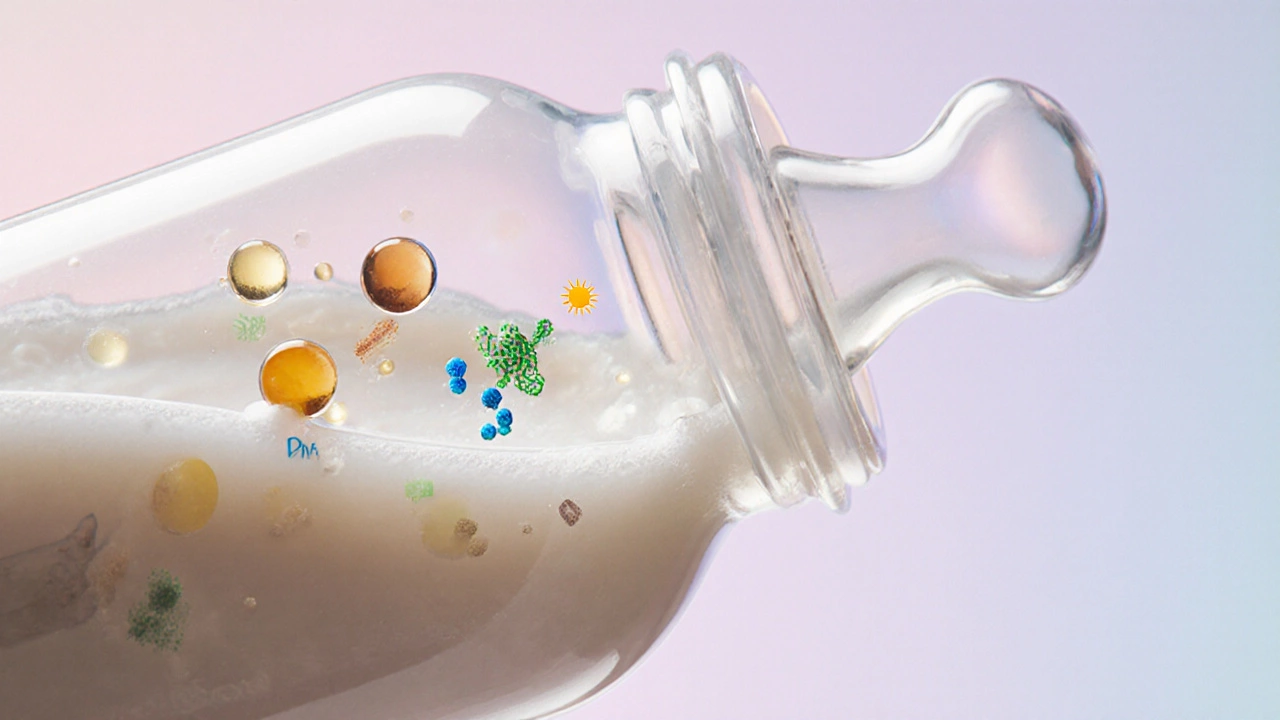Healthiest Baby Formula: Expert Guide 2025

Choosing the healthiest baby formula can feel like navigating a supermarket maze blindfolded. Between organic claims, DHA buzz, and endless price tags, most parents wonder which option truly supports a newborn’s growth without hidden trade‑offs. This guide breaks down the science, the ingredients, and the real‑world performance of today’s top formulas so you can decide with confidence.
What Exactly Is Baby Formula?
In the nutrition world, baby formula is a manufactured food designed to mimic the nutritional profile of human breast milk for infants who are not breastfed or need supplemental feeding. It provides calories, protein, fats, vitamins, and minerals in a liquid or powdered form. While the goal is to match breast milk as closely as possible, the composition varies widely based on the base (cow’s milk, soy, or specialty proteins) and added nutrients.
Key Nutrients Every Healthy Formula Should Contain
Modern formulas are fortified with components that support brain and eye development, gut health, and immune function. Below are the non‑negotiables:
- DHA (docosahexaenoic acid, an omega‑3 fatty acid critical for brain development) - most research links higher DHA levels with better visual acuity and cognition in the first year.
- ARA (arachidonic acid, an omega‑6 fatty acid that works alongside DHA for neural growth) - a balanced DHA/ARA ratio mirrors what’s naturally found in breast milk.
- Prebiotics (non‑digestible fibers that feed beneficial gut bacteria) - usually in the form of GOS (galactooligosaccharides) or FOS (fructooligosaccharides).
- Probiotics (live beneficial bacteria such as Bifidobacterium that help balance the infant gut microbiome) - increasingly common in premium formulas.
- Iron - essential for preventing anemia, especially after six months.
- Vitamin D - supports calcium absorption and bone health.
Types of Formula and Their Health Implications
Not all formulas are created equal. Below is a quick look at the main categories and what makes each one tick.
- Cow's Milk‑Based Formula (the most common type, using modified cow’s milk protein to resemble human milk) - fortified with DHA, ARA, and sometimes pre‑/pro‑biotics. Generally well‑tolerated unless the baby has a milk protein allergy.
- Soy‑Based Formula (uses soy protein instead of dairy, suitable for families avoiding animal products) - contains phytoestrogens and is often fortified with calcium and iron. Not recommended for infants with soy allergy or certain metabolic conditions.
- Organic Formula (produced following strict organic farming standards, limiting pesticide residues and synthetic additives) - may be cow’s milk‑based or soy‑based, and often carries the USDA Organic seal. Health‑wise, the main benefit is reduced exposure to certain contaminants.
- Hypoallergenic (HA) Formula (contains extensively hydrolyzed proteins or amino acids for babies with severe milk protein allergy) - essential for allergy‑prone infants but usually more expensive and sometimes less palatable.

Top Picks for 2025: Comparison Table
| Brand & Product | Base Type | Key Nutrients | Organic Certified? | Price (USD/oz) | Age Range |
|---|---|---|---|---|---|
| Similac Pro‑Advance | Cow's milk | DHA, ARA, 2‑Prime prebiotic blend | No | 0.45 | 0-12 months |
| Enfamil Neuro Pro | Cow's milk | DHA, ARA, Lactoferrin, MFGM | No | 0.48 | 0-12 months |
| Earth’s Best Organic | Organic cow's milk | DHA, ARA, organic DHA from algae | USDA Organic | 0.55 | 0-12 months |
| Gerber Good Start Soy | Soy | DHA, ARA, prebiotic GOS | No | 0.42 | 0-12 months |
| Holle Organic Infant Formula | Organic cow's milk | DHA, ARA, probiotic L. reuteri | EU Organic | 0.70 | 0-12 months |
| Nutramigen HA | Hydrolyzed protein | Extensively hydrolyzed whey, added DHA | No | 0.80 | 0-12 months |
How to Pick the Right Formula for Your Baby
Even with a table in front of you, the final decision hinges on three personal factors:
- Allergies or sensitivities. If your pediatrician suspects a cow’s milk protein allergy, jump straight to a hypoallergenic or soy option.
- Family values. Organic certification matters if you want to limit pesticide exposure.
- Budget. Premium formulas can cost up to double the standard options. Consider mixing a high‑quality base with an occasional specialty formula.
Here’s a quick decision flow:
- Is your baby diagnosed with a milk protein allergy? -> Choose hypoallergenic (e.g., Nutramigen HA).
- Do you prefer plant‑based nutrition? -> Try soy (Gerber Good Start Soy) or a dairy‑free specialty.
- Do you value organic sourcing? -> Pick Earth’s Best Organic or Holle Organic.
- Otherwise, a fortified cow’s milk‑based formula with DHA/ARA (Similac Pro‑Advance or Enfamil Neuro Pro) offers solid nutrition at a reasonable price.
Common Myths and Pitfalls
Myth #1: "Organic automatically means healthier for the baby." In reality, organic rules focus on farming practices, not on the specific nutrient profile. An organic formula can still lack DHA or have sub‑optimal iron levels.
Myth #2: "Soy formula is the best alternative to breast milk." Soy provides protein but lacks some bioactive components found in dairy‑based formulas, such as certain whey proteins that aid digestion. It’s fine for families avoiding animal products, but not necessarily superior nutritionally.
Pitfall: Switching brands too often. Sudden changes can upset a baby’s stomach and lead to gas or loose stools. If you need to switch, do it gradually over a week by mixing increasing amounts of the new formula.

Quick Checklist for the Healthiest Choice
- Contains DHA & ARA in a 1:1 to 2:1 ratio.
- Iron ≥ 0.75mg/100kcal (meets AAP guidelines).
- Added prebiotic blend (GOS/FOS) and, if possible, probiotic L. reuteri.
- Certified organic if pesticide exposure is a concern.
- No added sugars, corn syrup, or artificial flavors.
- Matches your baby’s age and any medical needs.
Frequently Asked Questions
Frequently Asked Questions
Can I give my baby a regular cow’s milk formula if they have a family history of allergies?
A family history alone isn’t a contraindication, but watch for symptoms like rash, vomiting, or persistent colic. If any appear, talk to your pediatrician about switching to a hypoallergenic or soy option.
Is DHA really necessary in formula?
Yes. Multiple studies show that infants who receive DHA have better visual tracking and early language milestones. Most reputable formulas now include DHA sourced from algae or fish oil.
How long can my baby stay on formula before switching to solid foods?
Most babies transition to solids around 6 months while still getting most calories from formula. By 12 months, you can start reducing formula to a few ounces a day and introduce whole milk if there’s no dairy allergy.
Are there any formulas that support gut health beyond pre‑biotics?
Yes. Some premium brands add live probiotic strains such as L. reuteri, which research links to reduced colic and improved stool consistency.
Is it safe to mix powdered formula with water from a filtered bottle?
Use boiled water that’s cooled to 70°C (158°F) for the first few batches to kill any bacteria. After the baby’s immune system matures (around 3 months), you can switch to filtered tap water that meets local safety standards.
With these facts in hand, you can feel confident picking a formula that aligns with your baby’s health needs, your family values, and your budget. Remember, the “healthiest” label isn’t one‑size‑fits‑all-look for the nutrient profile, quality certifications, and how your child reacts. Happy feeding!

